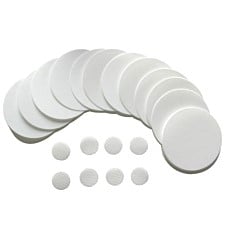
Last month we examined filter selection strategies for maximizing service life in continuous use applications. In this 3rd installment, we will examine the use of prefilters to extend service life.
Clarifying liquids with high levels of suspended solids is challenging, especially for applications requiring submicron filtration. In these applications, filter users who experience frustratingly short service life should consider using prefilters. A suitable prefilter will reduce the particle fouling of the final filter and, consequently, the combination will have better total throughput than the final filter alone.
In general, the amount of particulate a filter can accommodate before becoming clogged is related to its pore size rating. As filter pore sizes decrease, the smaller pores have reduced void volumes and reduced capacity for holding particulate. Conversely, as filter pore sizes increase, the larger pores have increased void volumes and increased capacity for holding particulate. It follows that the finer pore structures of membrane filters have less dirt holding capacity when compared to the larger pore structures of nonwoven media filters. Therefore, nonwoven media filters can be an excellent prefilter choice to extend the service life of membrane filters.
Prefilters are selected with a pore size rating larger than that of the final filter. This takes advantage of the inherent greater dirt holding capacity of larger pore sizes. Typically, binderless glass fiber media filters are chosen as prefilters for membrane disk filter applications. These nonwoven media filters have very good dirt holding capacity, are typically less expensive than membrane filters, and have broad chemical resistance. For membrane filters rated at <1 micron, Sterlitech Grade B glass fiber filters can be good prefilter candidates. For membrane filters rated at >1 micron, Sterlitech Grade D glass fiber filters may be a better prefilter option. For applications where glass fiber media cannot be used, polypropylene nonwoven filters (listed as “polypropylene nominal prefilters”) can be considered.
When nonwoven media disk filters are used as prefilters in pressure and vacuum disk filter holders, they are selected with diameters that are slightly smaller than the o-ring seals in the holders. This ensures they do not interfere with o-ring seals and cause leaks or bypass. To determine the correct prefilter size, please refer to the “application/specification” tab on the product page for the holder. For example, the correct prefilter diameter for the KG47 47mm vacuum filter holder can be read from the “Application/Specification” tab to be 35mm.
For users preferring the convenience of syringe filters, several of the non-sterile membrane options are available with incorporated glass fiber prefilters: cellulose acetate (CA), nylon , polypropylene , and PTFE . Alternatively, standalone glass fiber syringe filters may be used as prefilters for any syringe filters or disk filter pressure holders. Sterlitech also offers custom syringe filters that may be specified with a variety of incorporated prefilters.
Some applications may have particle size distributions that contain too many small particles for nonwoven media prefilters to be effective. In these applications, a membrane prefilter may be considered. For membrane filters with symmetric pore structures, such as nylon or CA membranes, the pore size of the prefilter is typically selected that is two or three pore size rating steps larger than the pore size of the final filter. For example, a 0.65 or 0.8 micron rated nylon membrane prefilter would be selected for a 0.2 micron rated nylon membrane final filter. For membrane filters with asymmetric pore structures, such as PES membranes, the pore size of the prefilter is typically selected that is three or four steps larger than the pore size of the final filter. For example, a 1.2 or 5.0 micron rated PES membrane prefilter would be selected for a 0.45 micron rated PES final filter. Some experimentation is often required to select a prefilter pore size rating that is optimal for total throughput.
When membrane prefilters are used in pressure and vacuum disk filter holders, they are selected with the same diameters as the final filters. It is presumed that the prefilter membrane filters will achieve good seals with the o-rings. If polycarbonate track-etch (PCTE) or polyester track-etch (PETE) membrane disk filters are stacked on top of each other, polyester drain disks should be used between the filters to ensure good flow and prevent pore blinding. For proper closure and to avoid excessive pressure drop, we recommend that you do not use more than two disk filters simultaneously in the pressure and vacuum disk filter holders.
For continuous use applications with high levels of suspended solids, incorporating a larger pore size prefilter ahead of the target pore size final filter can often result in a combination that has lower overall filtration costs than operating the final filter by itself. An optimal prefilter reduces the particle loading experienced by the final filter and, consequently, extends the service life of the final filter.
When considering cost, performance, and longevity, it can be complicated to select the optimal filters for an application. Experimentation and analyses are beneficial, if not required, to assist with filter selection. We hope you’ve found this series helpful for selecting filters for your projects. Please feel free to contact us if you need any guidance or technical assistance.


![Join Sterlitech at BIO 2024 [Booth #5558]: Exploring the Future of Biotechnology](https://www.sterlitech.com/media/magefan_blog/b4.jpeg)

